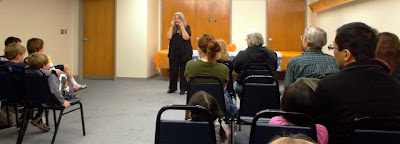Storytelling does not happen in a vacuum. It requires more than one person, an audience, a space. And sometimes, more than one performer--and the additional performer(s) need not be a storyteller.
The longer I follow this storytelling path, the more I find myself working with others to create new programs and new venues. Sometimes it might be a workshop offered with another presenter; at other times, a performance with two, three or even more storytellers and musicians. It could be simply sharing travel to some distant event--but that travel time offers opportunities to share experiences and brainstorm new ideas.
This past year has held many such ventures as I traveled and presented in places as far away as Albany, New York and as close as my own little town of Ripley, West Virginia. In March I organized the second storytellers retreat in Sistersville, West Virginia. Storytellers from Ohio, West Virginia and Pennsylvania came together to work on stories they wanted to take to the next level. As part of our weekend, we offered a concert of Celtic stories and songs at the Gaslight Theater. The theater owner was supportive and enthusiastic, and that event led to a ghost stories concert in October at the Gaslight. Collaboration can provide many avenues to work with communities and businesses to an end that is beneficial to all.
My journey to Albany included traveling to Buffalo to meet a fellow storyteller and to travel together to the conference. We filled the trip with conversation, ideas, stories, and interesting forays into places that caught our interest along the way. My friend was there as I presented my workshop on Appalachian ballads and gained insight into the kind of material I present. As we returned home, we discussed possible ways we could work together, even though we were separated by seven hours of road time. This summer, my friend took her vacation in my area and we again had time to go exploring. At one historic site we visited, we mentioned to a guide that we were storytellers--and that led to his suggestion that we contact a local Celtic Festival about performing there next year. We did, they're interested and now we are negotiating with them.
To me, storytelling and music are natural companions so I was delighted last year when my friend Jeff agreed to present a program of Christmas carols and the stories behind them. We developed our program and were had several performances. This year, we're presenting it again--and Jeff also joined the storytellers for the ghost stories program, providing ghostly songs to add to our concert. Another musician friend well known for her dulcimer music suggested that we do a performance together for an elderhostel. She had never worked with a storyteller before but was intrigued by the possibility. We planned a set that transitioned well between stories and songs and ballads; it was a memorable evening.
Poets can also be a natural fit in a storytelling concert. I've worked with poets and authors at the WV State Folk Festival for the past 5 years to present programs in the Oral Traditions tent. Spoken and written word weave together well, giving audiences a variety of voices and styles that keeps them interested and engaged.
I could give many more such examples; this has been a year of collaboration certainly, and a year of growth as I seek new ways to bring storytelling to more people in more venues. While the traditional storytelling festival or concert still draws good crowds in many areas, these different approaches to presenting the oral art of storytelling can find new audiences for this ancient art.
Copyright 2012 by Susanna Holstein, No republication or redistribution allowed without permission of Susanna Holstein. Please write to susannaholstein@yahoo.com to request information about use of this article.

